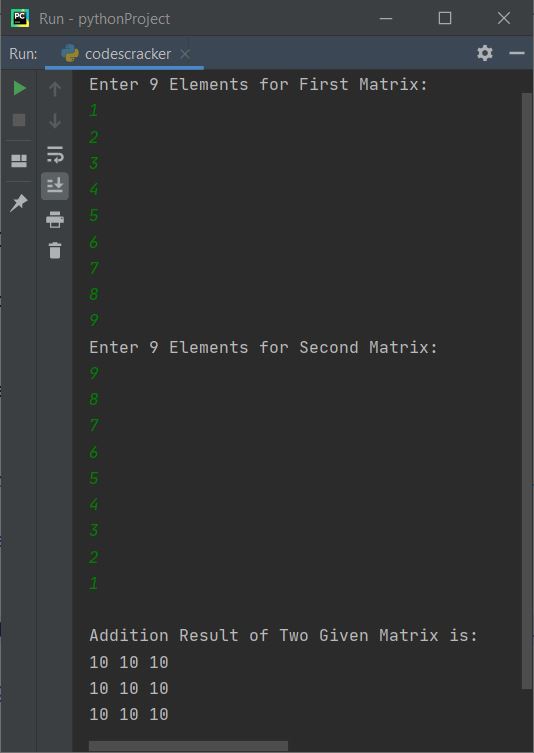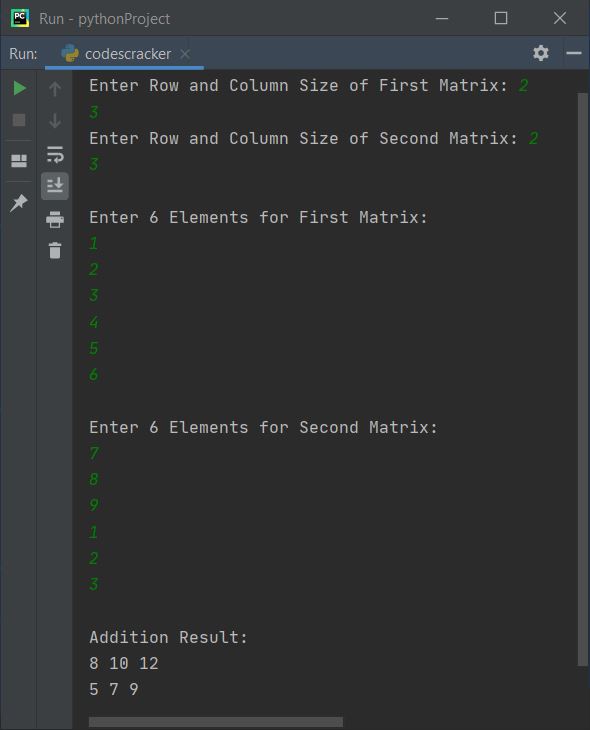- Python Basic Programs
- Python Program Examples
- Python Print Hello World
- Python Get Input from User
- Python Add Two Numbers
- Add Subtract Multiply Divide
- Python Check Even or Odd
- Python Check Prime or Not
- Python Check Alphabet or Not
- Python Check Vowel or Not
- Python Check Leap Year or Not
- Check Reverse equal Original
- Check Positive Negative Zero
- Python Check Armstrong or Not
- Python Check Palindrome or Not
- Python Check Perfect Number
- Python Find Reverse of Number
- Python Count Digits in Number
- Python Add Digits of Number
- Sum of First and Last Digits
- Python Product of Mid Digits
- Sum of Squares of Digits
- Interchange Digits of Number
- Python Sum of n Numbers
- Python Print ASCII Values
- Python Swap Two Numbers
- Python Swap Two Variables
- Python Fahrenheit to Celsius
- Python Celsius to Fahrenheit
- Python Display Calendar
- Python Days into Years, Weeks
- Find Largest of Two Number
- Find Largest of Three Number
- Python Print Fibonacci Series
- Generate Armstrong Numbers
- Python Make Simple Calculator
- Python Add Binary Numbers
- Binary Number Multiplication
- Python Mathematical Programs
- Find Sum of Natural Numbers
- Find Average of n Numbers
- Python Print Multiplication Table
- Print Table using Recursion
- Python Find Average Percentage
- Python Find Grade of Student
- Find Square Root of Number
- Python Print Prime Numbers
- Find Numbers Divisible by
- Python Find Factors of Number
- Python Find Factorial of a Number
- Python Find HCF & LCM
- Python Kilometres to Miles
- Python Find Area of Square
- Python Find Area of Rectangle
- Python Find Area of Triangle
- Python Find Area of Circle
- Python Find Perimeter of Square
- Find Perimeter of Rectangle
- Python Find Perimeter of Triangle
- Find Circumference of Circle
- Python Simple Interest
- Python Solve Quadratic Equation
- Python Different Set of Operations
- Python Display Powers of 2
- Python Find nCr & nPr
- Python Pattern Programs
- Python Print Pattern Programs
- Python Print Diamond Pattern
- Python Print Floyd's Triangle
- Python Print Pascal's Triangle
- Python List Programs
- Python Count Even/Odd in List
- Python Positive/Negative in List
- Python Even Numbers in List
- Python Odd Numbers in List
- Python Sum of Elements in List
- Sum of Odd/Even Numbers
- Python Element at Even Position
- Python Element at Odd Position
- Python Search Element in List
- Python Largest Number in List
- Python Smallest Number in List
- Python Second Largest in List
- Python Second Smallest in List
- Python Insert Element in List
- Python Delete Element from List
- Python Multiply Numbers in List
- Swap Two Elements in List
- Python 1D Array Program
- Python Linear Search
- Python Binary Search
- Python Insertion Sort
- Python Bubble Sort
- Python Selection Sort
- Remove Duplicates from List
- Python Reverse a List
- Python Merge Two List
- Python Copy a List
- Python Conversion Programs
- Python Decimal to Binary
- Python Decimal to Octal
- Python Decimal to Hexadecimal
- Python Binary to Decimal
- Python Binary to Octal
- Python Binary to Hexadecimal
- Python Octal to Decimal
- Python Octal to Binary
- Python Octal to Hexadecimal
- Python Hexadecimal to Decimal
- Python Hexadecimal to Binary
- Python Hexadecimal to Octal
- Python Matrix Programs
- Python Add Two Matrices
- Python Subtract Two Matrices
- Python Transpose Matrix
- Python Multiply Matrices
- Python String Programs
- Python Print String
- Python Find Length of String
- Python Compare Two Strings
- Python Copy String
- Python Concatenate String
- Python Reverse a String
- Python Swap Two Strings
- Python Uppercase to Lowercase
- Python Lowercase to Uppercase
- Python Check Substring in String
- Python Count Character in String
- Count Repeated Characters
- Python Count Word in Sentence
- Python Count Each Vowels
- Python Capitalize Character
- Python Capitalize Word in String
- Python Smallest/Largest Word
- Remove Spaces from String
- Remove Duplicate Character
- Remove Vowels from String
- Remove Punctuation from String
- Python Remove Word in String
- Python Remove Duplicate Words
- WhiteSpace to Hyphens
- Replace Vowels with Character
- Replace Character in String
- Python Sort String in Alphabetical
- Sort Word in Alphabetical Order
- Extract Number from String
- Python Check Anagram Strings
- Python File Programs
- Python Read a File
- Python Write to File
- Python Append Text to File
- Python Copy Files
- Python Merge Two Files
- Python Counts Characters in File
- Python Count Words in File
- Python File Content in Reverse
- Python Lines Contains String
- Python Delete Line from File
- Python Capitalize Word in File
- Python Replace Text in File
- Replace Specific Line in File
- Python Find Size of File
- Python List Files in Directory
- Python Delete Files
- Python Misc Programs
- Python Reverse a Tuple
- Python Merge Two Dictionary
- Python bytes to String
- Python bytearray to String
- Generate Random Numbers
- Python Print Address of Variable
- Python Print Date and Time
- Python Get IP Address
- Python Shutdown/Restart PC
- Python Tutorial
- Python Tutorial
Python Program to Add Two Matrices
In this article, you will learn and get code in Python to add two matrices entered by user at run-time. Here are the list of programs on matrix addition in Python:
- Add Two 3*3 Matrices
- Add Two Matrices of Given Size
Note - Before starting the program, if you're not aware about, how the addition of any two matrices gets defined, refer to Matrix Addition to get every required thing. Now let's start the program.
Add Two Matrices in Python
This program find and prints the addition result of two given 3*3 matrices. Here 3*3 matrix means, matrix of 3 rows and 3 columns.
matOne = [] print("Enter 9 Elements for First Matrix: ") for i in range(3): matOne.append([]) for j in range(3): num = int(input()) matOne[i].append(num) matTwo = [] print("Enter 9 Elements for Second Matrix: ") for i in range(3): matTwo.append([]) for j in range(3): num = int(input()) matTwo[i].append(num) matThree = [] for i in range(3): matThree.append([]) for j in range(3): matThree[i].append(matOne[i][j]+matTwo[i][j]) print("\nAddition Result of Two Given Matrix is:") for i in range(3): for j in range(3): print(matThree[i][j], end=" ") print()
Here is the initial output produced by this Python program:

Now supply inputs say 1, 2, 3, 4, 5, 6, 7, 8, 9 as nine elements for first and 9, 8, 7, 6, 5, 4, 3, 2, 1 as nine elements for second matrix, to add these two given matrices as shown in the following snapshot:

Note - In above program, we've used nested list to apply the thing to perform matrix addition. That is, with following statement:
matOne = []
a list named matOne gets defined. And using the following statement:
matOne.append([])
Another empty list gets appended to matOne. Now matOne becomes nested list. For example, if user enters the same input as provided in above sample run. then matOne holds those numbers in this way:
matOne = [[1, 2, 3], [4, 5, 6], [7, 8, 9]]
Add Two Matrices of Given Size by User
This program does the same job as of previous program. The only difference is, this program allows user to define the size of matrix along with its elements.
print("Enter Row and Column Size of First Matrix: ", end="") rowOne = int(input()) colOne = int(input()) print("Enter Row and Column Size of Second Matrix: ", end="") rowTwo = int(input()) colTwo = int(input()) if rowOne==rowTwo and colOne==colTwo: matOne = [] print("\nEnter " +str(rowOne*colOne)+ " Elements for First Matrix: ") for i in range(rowOne): matOne.append([]) for j in range(colOne): num = int(input()) matOne[i].append(num) matTwo = [] print("\nEnter " +str(rowTwo*colTwo)+ " Elements for Second Matrix: ") for i in range(rowTwo): matTwo.append([]) for j in range(colTwo): num = int(input()) matTwo[i].append(num) matThree = [] for i in range(rowOne): matThree.append([]) for j in range(colTwo): matThree[i].append(matOne[i][j]+matTwo[i][j]) print("\nAddition Result:") for i in range(rowOne): for j in range(colOne): print(matThree[i][j], end=" ") print() else: print("\nDimension Mismatched!")
Here is its sample run with user input, 2 as row size and 3 as column size of both matrices. Then 1, 2, 3, 4, 5, 6 as six elements for first and 7, 8, 9, 1, 2, 3 as six elements for second matrix:

Same Program in Other Languages
« Previous Program Next Program »
Liked this post? Share it!
/** * Note: This file may contain artifacts of previous malicious infection. * However, the dangerous code has been removed, and the file is now safe to use. */